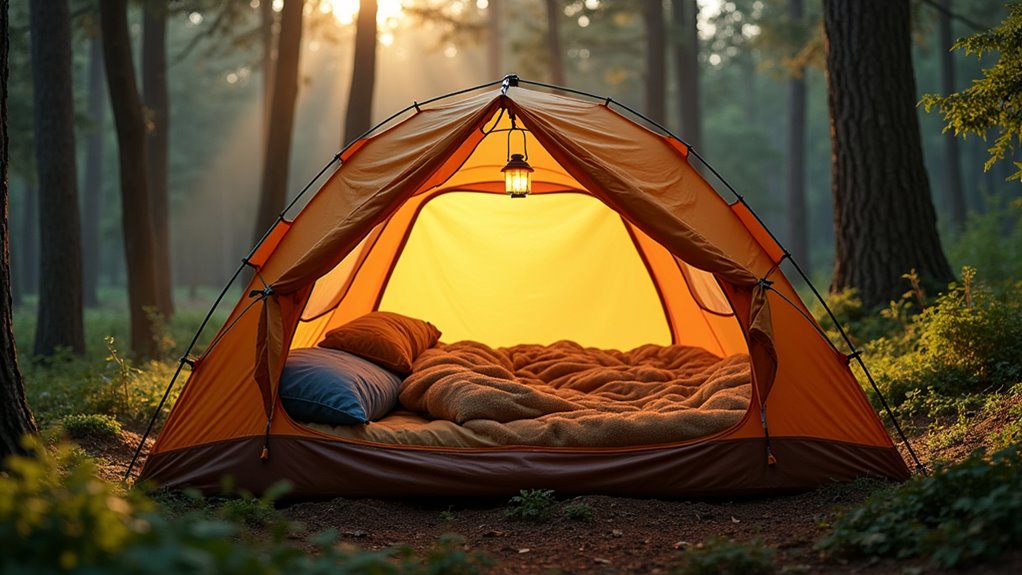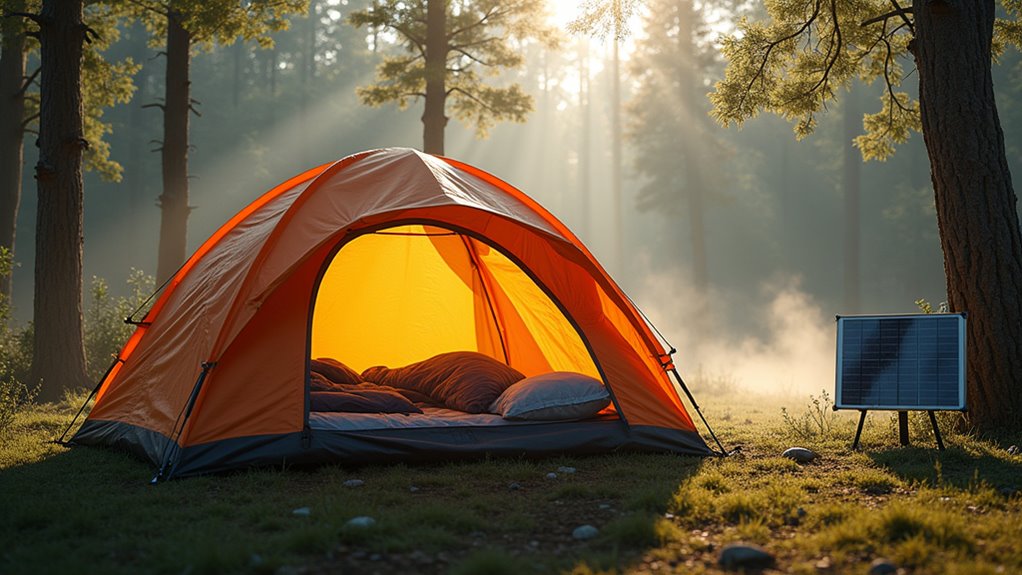Does Tent Matter For Insulation
This post contains affiliate links. As an Amazon Associate, we earn from qualifying purchases.
Tent choice significantly impacts insulation by influencing heat retention and airflow. Using materials like closed-cell foam liners or thicker fabrics such as Oxford 300 PU 4000 helps reduce heat loss and enhances comfort. Cotton canvas provides good warmth retention but adds weight, while polyester improves ventilation without trapping heat. Double-wall designs effectively trap air, and proper ventilation balances temperature and humidity. Further explanation and supporting details will be provided later in the article for those interested in a deeper understanding.
Essential Facts in 30 Seconds
- Tent materials affect thermal resistance and comfort in different weather.
- Thicker insulation improves warmth retention by up to 50%.
- Fabric type influences airflow and heat retention, impacting insulation.
- Proper ventilation controls moisture and maintains insulation efficiency.
- Advanced insulation technologies adapt to weather for better comfort.
Importance of Insulation Thickness in Tents
Insulation thickness in tents matters a lot. It helps keep the tent warm during cold nights. It also keeps the tent cool on hot days. Thicker insulation blocks heat from moving in or out. This keeps the temperature inside steady and comfortable. Studies show thicker layers can improve warmth by up to 50%. This matters in cold or extreme weather.
Thicker insulation adds weight to the tent. It can also make the tent harder to set up. Some tents use special designs like baffles or liners. These stop the insulation from getting squished. That keeps the insulation working well. A well-insulated tent can also reduce wind resistance, which enhances overall warmth and comfort. Additionally, a four-season tent is specifically designed to provide enhanced insulation for winter conditions.
A well-insulated tent saves energy too. You need less heating fuel or power to stay warm. This makes camping safer and more eco-friendly.
Impact of Tent Materials on Thermal Resistance
Tent materials affect how warm or cool you feel inside. Cotton canvas keeps heat well but can be heavy and less breathable. Polyester lets air flow better but may not keep warmth as long. Some tents use special insulation layers to trap heat. Transparent fabrics let sunlight in, warming the tent during the day. These choices matter a lot for comfort in different weather. Choose a tent fabric that fits your needs for heat and airflow. Additionally, understanding tent material differences can significantly influence your decision on insulation and comfort during your camping experience. For instance, canvas tents provide excellent insulation while maintaining breathability, making them suitable for diverse climates.
Material Types and Properties
Different tent materials change how warm or cool you feel inside. Material choice affects warmth and strength. Here are key facts:
- Polyester: Resists water well and lasts long. Breathes less, so moisture can build up inside. Regularly applying dedicated waterproofing spray can enhance its performance and longevity.
- Nylon: Very light and tough. Not much air flows through, which can feel stuffy. Coatings block water but may change warmth. Ensuring the fabric is in good condition before use can help maintain its thermal properties.
- Cotton Canvas: Keeps heat in and lets air pass. Controls moisture better, stopping dampness. Additionally, proper maintenance of tent materials is crucial for ensuring thermal resistance and comfort in varying weather conditions.
Think about weather and comfort when picking tent fabric.
Fabric Transparency Effects
Fabric transparency affects how much heat your tent keeps. Dyneema tents let infrared rays pass through easily. This causes a lot of heat to escape, like an open window.
Polyester and nylon block more infrared rays. They keep the tent warmer inside. Double-wall tents help, too. They trap air between layers, stopping heat from escaping. Additionally, tent materials like canvas provide excellent insulation properties for temperature regulation, making them ideal for colder conditions.
Tent color matters, too. Dark colors can make your tent lose heat faster. Light colors help keep the warmth.
Good airflow is key. Small airflow stops dampness but doesn’t waste heat. This balance makes camping more cozy and warm. Additionally, ensuring your tent is properly waterproofed can further enhance its thermal resistance by preventing moisture buildup, which can lead to heat loss.
Insulation Layer Innovations
Selecting the right tent materials makes camping warmer and more comfortable. New insulation layers use smart designs to keep heat inside. These changes help tents stay cozy, even in cold weather.
First, multi-layer fabrics trap air between layers. Air acts like a blanket, stopping heat from escaping. This keeps the tent warmer for longer.
Second, reflective coatings bounce heat back into the tent. They work like mirrors that keep warmth inside. This feature is great for cold nights.
Third, advanced weaves create tight fabrics that block wind and hold heat. These strong weaves make tents last longer and stay warm.
Additionally, a 4 season tent is built specifically to handle extreme weather, enhancing overall insulation and comfort.
Together, these innovations improve how tents keep you warm outdoors. Simple, smart materials mean better protection from cold weather.
Role of Fabric Properties in Temperature Control
Fabric properties play a big role in controlling temperature inside your tent. Breathable fabric lets moisture escape and stops water drops from forming inside.
Tents with low thermal conductivity keep heat inside better during cold weather. Dark colors soak up sunlight and warm the tent during the day. Light colors bounce sunlight away and keep the tent cooler. But light colors may lose more heat at night.
Tents with built-in insulation panels hold warmth well. These features help keep you comfortable in different weather. Knowing how fabric works helps you pick the right tent. Additionally, using materials like tent with foil can significantly enhance insulation and warmth retention during chilly nights.
Ventilation: Balancing Heat Retention and Moisture Management

Proper ventilation keeps your tent warm and dry. It stops moisture from building up inside. Moist air causes dampness and discomfort. Fresh air flow helps you feel comfortable all night.
Place your tent so wind can blow through. Use vents and mesh windows on different sides. This lets air move in and out easily. Leave doors and windows partly open. This keeps air moving without letting cold in.
Good airflow reduces fog on your tent walls. It also stops mold from growing inside. Well-ventilated tents keep your gear dry too.
Stay warm and feel fresh with smart ventilation.
Climate Considerations for Tent Insulation Effectiveness
Climate affects how well tent insulation works.
Cold places need materials with high R-values. These materials stop heat from escaping.
Hot places need insulation that blocks heat from coming in. This keeps the tent cooler.
Knowing this helps you pick the right insulation. Stay comfortable no matter the weather.
Cold Climate Insulation Needs
Cold weather needs strong insulation to keep you warm and safe. Camping in cold places means using the best gear and smart tips.
Here are three important points:
- Pick a tent made for cold weather. Use tents with double-coated PVC to block wind well. All-season tents work great too.
- Use thick sleeping pads with high R-values. Add thermal liners for extra warmth during cold nights.
- Set your tent close to the ground. Close all openings tightly to stop cold air and moisture from coming in.
Good insulation keeps you warm and makes camping fun, even in cold weather.
Hot Climate Adaptation Strategies
Camping in hot climates needs smart tent insulation. Reflective layers on your tent’s outside cut heat by bouncing sunlight away.
Double-layer tents with air pockets block heat better and keep the inside cooler. Use thermal liners made from materials like closed-cell foam to stop heat from entering.
Fabrics like Oxford 300 PU 4000 work well; they keep heat out and resist water. Good airflow matters too. Air moves through vents without letting heat in, keeping your tent fresh and cool.
These steps help you stay comfortable under the hot sun.
Future Innovations in Tent Insulation Technologies

Tent insulation is changing fast. New tech makes camping warmer and more comfortable. Here are three big innovations to know:
- Smart Temperature Control: Sensors inside tents sense heat changes. They adjust insulation or warn you about weather shifts.
- Sustainable Fabrics: More tents use recycled and natural materials like stone wool. These keep you warm and protect the planet.
- Modular Designs: Tents let you add or remove insulation parts. This fits different weather and cuts waste.
These advances make camping easier and greener. You stay cozy and help the Earth at the same time. Ready for any weather.
Frequently Asked Questions
How Does Tent Color Affect Heat Absorption and Insulation?
Tent color changes how much heat it holds inside. Dark tents soak up heat fast. They make the inside hot during sunny days. Light tents bounce sunlight away. They keep the inside cooler and cozy. Studies show dark colors can raise tent temperature by 10°F or more. Bright tents reflect heat, helping you stay comfortable. Pick tent colors based on the weather you expect. This simple choice helps you enjoy your trip better.
Can I Use a Regular Tarp for Insulation Purposes?
A regular tarp does not work well for insulation. It blocks wind but does not stop heat from escaping. Tarps are thin and do not trap warm air inside. To keep a place warm, use materials designed for insulation, like foam boards or fiberglass. These materials slow down heat loss much better than tarps. Using a tarp alone feels like trying to hold smoke with bare hands—ineffective and frustrating. For cold weather, trust proper insulation to stay warm and save energy.
What Is the Best Tent Shape for Insulation Efficiency?
Dome-shaped tents keep you warm best. Their shape lowers surface area, so heat stays inside. Add quilted layers or blankets for extra warmth. This setup works great for cold weather camping. Simple and smart.
How Do Ground Materials Impact Tent Insulation Performance?
Your ground cover acts like a blanket for your tent. Materials like foam or dry leaves stop heat from escaping. These materials have low thermal conductivity. This means they keep the cold from the ground away. Using the right ground cover helps you stay warm at night. It also makes sleeping outside more comfortable. Studies show foam pads reduce heat loss by up to 50%. Simple items on the ground matter a lot for tent warmth.
Are There DIY Insulation Options for Tents?
DIY insulation for tents works well to keep you warm. Use foam pads under your sleeping bag to stop cold from the ground. Wrap reflective foil around the tent walls to bounce heat back inside. Emergency blankets also trap body heat effectively. Add rugs or blankets on the floor for extra warmth. Natural materials like pine boughs or dry leaves make good insulation too. These simple steps can make your tent much cozier during cold nights.
Conclusion
Insulation in tents matters a lot for staying warm outdoors. Thick insulation and materials like polyester or nylon help keep heat inside. Good insulation stops cold air from coming in and warm air from escaping. Tents with reflective coatings or special liners can boost warmth. Ventilation also plays a key role. It prevents moisture buildup, which can make you feel cold. Think about the weather before camping. Cold places need better insulated tents. Warm places need tents that allow air flow. Knowing these facts helps you pick the right tent. You stay comfortable and enjoy your trip more.
